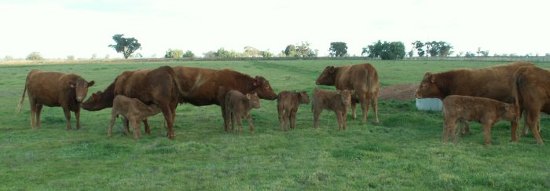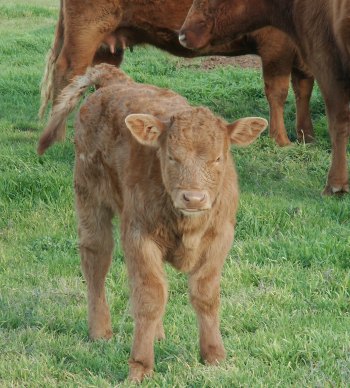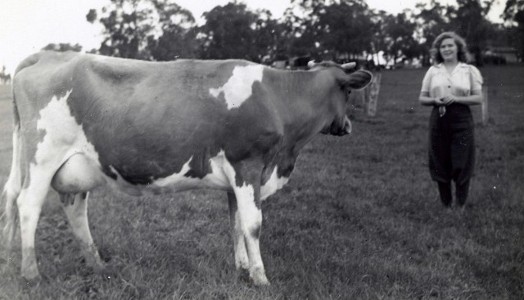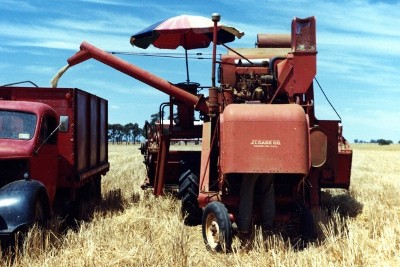Heavy Muscled & No Fuss!
Changing the Face of Blondes in Australia
Rupari Blondes - Worth Visiting
![Banya Welcome (Poll) [Rathdowney Tornado x Aruma Quartette (P)]](images/Welcome%2013%2010%203.JPG)
Rupari Polled Blondes’ is located in Northern Victoria near the town of Yarrawonga. All cattle are performance measured and BREEDPLAN recorded. Greatly enhanced genetic diversity is provided by an extensive AI program. Hence maximum opportunity exists to breed and identify animals of the highest quality and optimum performance.
Rupari Polled Blondes largely originated from females purchased from the "Banya" Blonde Stud dispersal at the end of 2007. Banya was established in 1988. A mix of French, Canadian, British and Australian bred AI sires have been used since.
Who is that cow? Banya Welcome (Poll) [Rathdowney Tornado x Aruma Quartette (P)]
Welcome is extremely heavily muscled, and in a very eye appealing way. She is moderate framed with exceptional length of body. Welcome is super fertile, having produced her first 6 calves at less than 12 month intervals, then flushed once for 20 embryos, and back in calf without missing a month; then flushed again for another 20 embryos, and instantly back in calf to AI. Welcome has a very quiet disposition.
Aim
Our target was to have greater than 90% of the Rupari female herd 'Polled' by the end of 2013. This was achieved a year ahead of schedule in 2012. We believe this has been done with no negative impact whatsoever on the major features of the Blonde d'Aquitaine breed, and it is quite reasonable to speculate that we have significantly improved some aspects such as temperament and milk production. We invite you to browse through the website and consider the prospects for yourself.
Objective
To provide ‘easy calving’, ‘placid’, ‘high growth rate’, ‘very heavily muscled’ Blonde sires producing “extra high value” progeny; and of course, preferably POLLED!
Philosophy
We will not sell stud cattle that we would not be happy to breed from ourselves.
Our Tag-line
"Changing the Face of Blondes in Australia"
Sires
Quality Poll Bulls available by private treaty.
Females
Seedstock females available by private treaty.
The Future
Polled, high performance seedstock that really do provide extra profit and less hassle.
Our Guarantee
We will NOT knowingly sell to you any cattle with structural, fertility or temperament faults. All bulls are sold with a 12 month structural and fertility guarantee. Females sold PTIC or with calf at foot have the fertility guarantee embodied in the product. Heifers sold unjoined, and older than 15 months of age, are warranted to fall pregnant within 6 months, subject to fertility and mating capability test of bulls used.

The Blonde Advantage - More $’s come from ‘B’ Muscle rumps
Muscle Pays - May 2009 (MLA Prograzier)
“Muscling is four times more likely to influence price variation across all classes of cattle than weight, and seven times more likely to influence price than fat score”, according to Brett Littler, a Beef Cattle officer with NSW DPI, who has done a detailed analysis of prices reported by the National Livestock Reporting Service. This statement is reported in the May 2009 issue of the MLA publication “Prograzier” which has been posted to all MLA members.
Muscle Pays - June 2012 (MLA News)
According to an MLA and Beef CRC-funded research project, for each unit of improvement in muscle score (eg D to C), producers can expect a 15–21¢/kg increase in price received at live cattle sales. Research Officer, Dr Linda Cafe, said the past two years of work, which also utilised 15 years of prior data from the NSW Department of Primary Industries’ came to this conclusion. The research also found that increased muscling substantially increased returns without compromising growth, feed efficiency or reproductive traits.
Conclusion
Both the above statements are based on an objective analysis of research and industry data by independent researchers. The evidence is indisputable; the financial gains from producing sale stock with more muscle, are very substantial.

Red Angus heifers with their Blonde X calves.

History
Bunyip
The Roberts family began farming with the purchase of a bush block on the Tonimbuk Road at Bunyip in Gippsland, Victoria, just after the end of the Second World War. Alf and Mary Roberts were among the first in Gippsland to contract the use of a bulldozer to clear the block. A dairy herd was established, and quickly developed into a purebred Guernsey herd supporting two families.

Bill & Geoff – after haymaking bath – 1947

Guernsey Cow & Betty - 1948
Mid
In the ‘60’s Geoff and Betty Roberts moved the farm to Whittlesea, Victoria; then to Mulwala, NSW. Commercial Angus cattle, sheep and cropping were the mainstay enterprises.
In 1975 a property at Burramine was purchased and a Red Angus stud and commercial herd became established over the next few years. A registered Poll Merino flock also played a significant role. The Red Angus herd was one of the early adopters of Breedplan and utilized some of the first Canadian Red Angus semen.

Harvest – late ’70’s

Red Angus bull – ‘Rupari Career’
Recent
Sometime in the mid ‘90’s the Red Angus herd went commercial and began some experimental cross breeding. A poll South Devon sire was introduced, back to some Red Angus from Jillangollo, then a poll Gelbvieh bull was purchased, back to a couple more Red bulls from Jillangollo, and then a couple of poll Limousin bulls were purchased. (Special thank you to Alex McDonald; Limousin Society.)
This culminated in the realization of the incredible financial advantage available to commercial beef producers by selling ‘B’ muscle calves. Greg and Linden still maintain a small commercial herd of Red Angus cows joined to Blonde bulls and enjoy the challenges of breeding the Blonde d’Aquitaine cattle you see today.

Shannon & Dougal’
Genetics
Understanding the Poll Gene
Having bred Red Angus for many years and never needing to deal with any issue related to horns, the concept of going backwards to create more work and a less desirable product, certainly seems foreign to us.
Most characteristics of cattle, such as growth, fertility, or feed conversion efficiency, are controlled by a very large number of genes. A few characteristics, such as polledness or red / black coat colour are controlled by a single pair of genes. [A single gene is made up of a pair of genes called ‘Alleles’ to form the one gene.] This is because one half of the gene comes from the male (sperm) and the other half from the female (egg). When we talk about one gene coming from the sire and one from the dam we are referring to two alleles which together form the single gene pair. Which one of any pair that an animal transmits to its progeny is purely a matter of chance.
There are a couple of principles that help us predict the outcome of particular joinings for single gene traits like polledness.
Dominance
For most single gene traits there are dominant and recessive forms of the gene. For most British and European cattle species horns are recessive and polled is dominant. The symbol used for polled is the capital letter P and the symbol for horns is lower case p. The combination of these genes in the pair of genes in each animal determines what the animal looks like and is called the phenotype, whereas thegenotype describes the actual genes present in the animal.
If an animal carries two horn genes (pp) it will be horned. If it carries two polled genes (PP) it will be polled. If it carries a polled gene and a horned gene (Pp) it will be polled because the polled gene is dominant.
Homozygous and Heterozygous
Animals which carry a pair of genes which are the same are called homozygous (homo means same). For example, for polledness, the animals carrying two polled genes (PP) or two horned genes (pp) are both homozygous. However, if the genes are different (Pp) the animal is heterozygous (hetero means different).
While we can be confident that all horned animals are homozygous for the horned gene (pp), it is more difficult to determine if a polled animal is homozygous (PP) or heterozygous (Pp) because they will both look the same.
Predicting the Outcome of a Mating
Each animal has a pair of genes of which only one is transmitted (randomly) to its offspring, which then ends up with a pair to form the gene pair for horn or poll. If we use a box to denote: At the top, the 2 genes available from the Bull; and down the left side, the 2 genes available from the Cow; we can place in the four squares the potential four combinations that can be achieved by taking either one of the 2 genes available from each animal.
PP x pp
When a homozygous polled bull (PP) is joined to a number of horned (pp) cows, all four possibilities are the same. The only options are to get a P from the bull, and a p from the cows. All calves will be heterozygous polled (Pp). They will look polled, but will carry one horn gene.
Pp x pp
Actually, nearly all polled Blonde bulls are heterozygous polled (Pp). If a heterozygous polled (Pp) bull is joined to a number of horned (pp) cows; the bull can offer either a Por a p and the cows can again only offer a p. There are two possibilities; heterozygous polled (Pp) and horned (pp). 50% of the calves will be polled (Pp) and 50% horned (pp). There can be no homozygous poll calves.
Pp x Pp
What is the result if some heterozygous polled (Pp) cows are joined to a heterozygous polled (Pp) bull? Both the bull and the cows can offer either a P or a p. The possibilities are: 25% of the calves will be PP (homo Poll), 50% of the calves will be Pp(hetero Poll), and the remaining 25% will be pp (horned). Thus the chances of breeding a homozygous polled bull (not heifer) would be 1 in 8.
PP x Pp
Finally, if a homozygous polled bull (PP) is joined to some hetero poll cows (Pp) the bull can offer only P, and the cows can offer either a P or a p. The result is 100% polled calves with 50% being PP (homo Poll) and 50% being Pp (hetero Poll). The difficulty is we still cannot easily identify the difference between the Pp and PP polled cattle.

A classic clean poll head on "Allie“